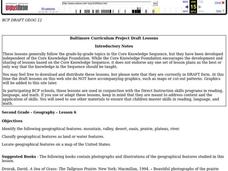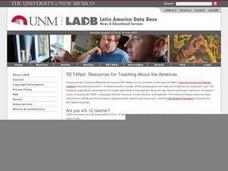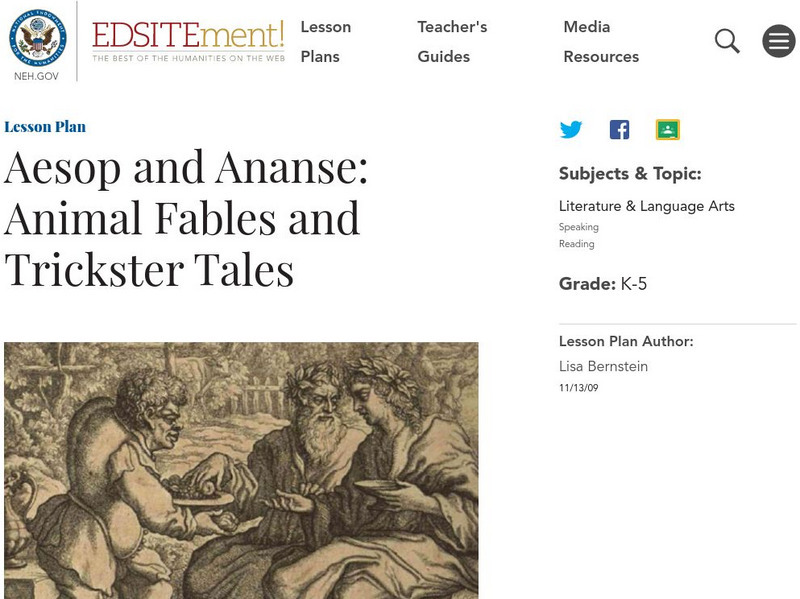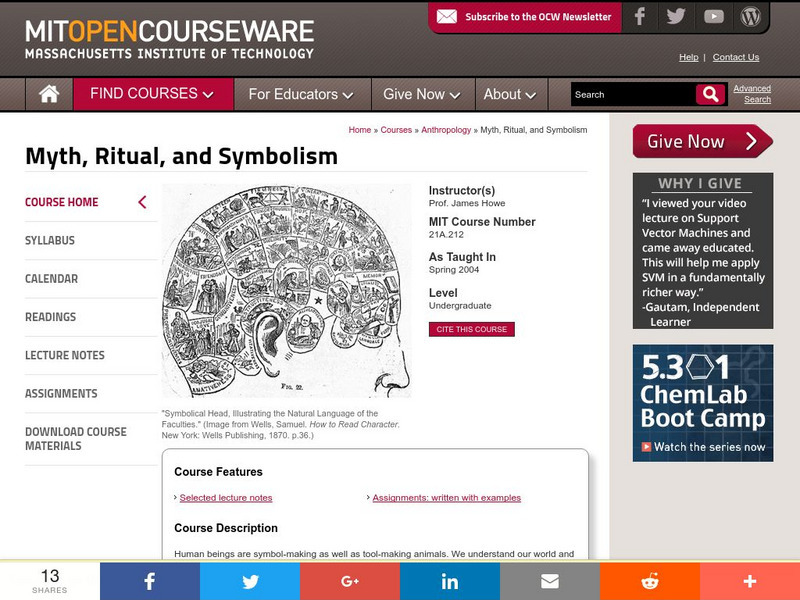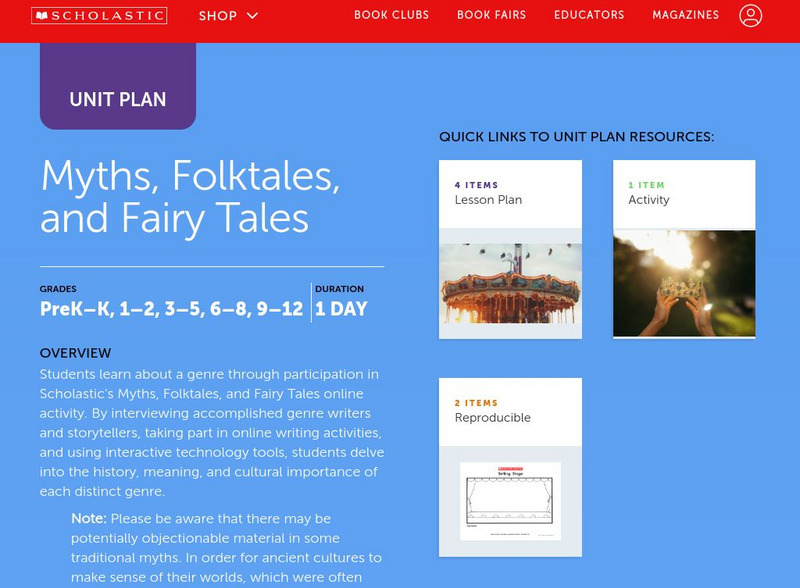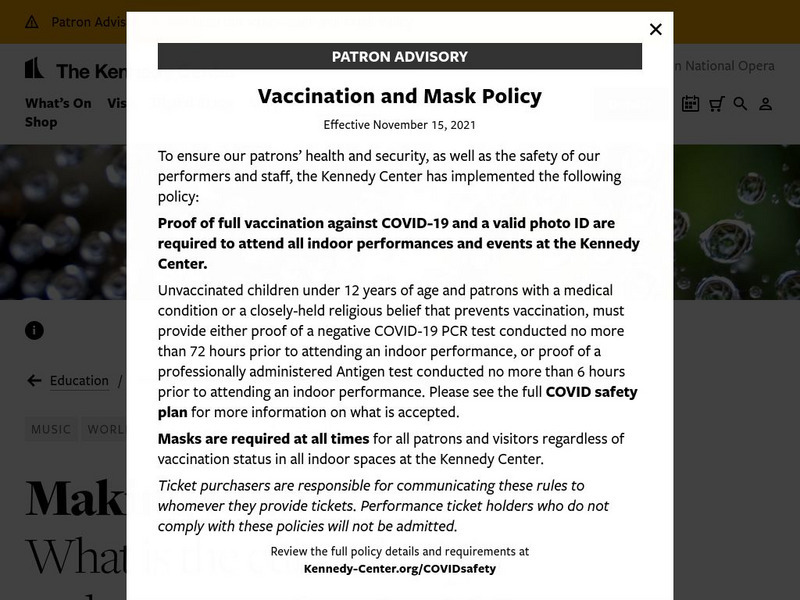Curated OER
Westward Expansion
Students examine how the events that took place during the time of the Westward Expansion affected the pioneers and Native Americans through the seven lessons of this unit. Enhancements in transportation over time are also a part of the...
Curated OER
Land of the Rising Sun
Students survey aspects of traditional and modern Japanese customs and beliefs in the seven lessons of this unit. Both the culture and the geography of the country are studied in this unit.
Curated OER
Geography
Second graders study and review geographical terms for features. They classify those features and locate them on a map. They review geographical features of Tall Tales.
Curated OER
Literature Overview of African Folktales
Students play a game of tug-of-war, participate in a discussion about the story, discuss the phrase "bigger doesn't mean better." , and illustrate a scene from the story.
Curated OER
Electronic Journals about Latin American Folktales
Students exchange folktales with a key-pal using dialog journal writing. They write out a folktale from their own cultural background and exchange it with students of another. They record their impressions of each other's folktales.
Curated OER
Most Wonderful Gift
Learners discover that folktales reveal a great deal about the place in which they originate. They identify physical and human characteristics of a place and explain how culture influences the way people think. They illustrate cultural...
Curated OER
Have I Got A Story For You - Folklore of Utah
Fourth graders identify the clues that folklore provides about Utah's past. They create a piece of folklore for a place or event in or near the community. They see that the legends and traditions we pass to one another are also sources...
Curated OER
Comparing African, American, and European Folktales
Learners listen to John Steptoe's story, "Mufaro's Beautiful Daughters," and then identify similarities and differences between an African, a Native American, and a European folktale.
Curated OER
Animal Act
Young scholars create original tales that use animals to portray human behavior.
National Endowment for the Humanities
Neh: Edsit Ement: Animal Fables and Trickster Tales
Animals and tricksters appear in folk tales from a wide variety of cultures, especially those with strong oral storytelling traditions. Use this lesson plan to introduce students to these characters and the lessons they were used to...
National Endowment for the Humanities
Neh: Edsit Ement: Born on a Mountaintop: Davy Crockett, Tall Tales & History
These four lesson plans integrate the life of Davy Crockett and the tall tales that were created about him. Includes a printable rubric, lesson extensions, links, and much more!
Massachusetts Institute of Technology
Mit: Open Course Ware: Myth, Ritual, Symbolism
University course site on symbolism, figurative language, and elements of myth and ritual includes lecture notes, bibliography, and examples of student work submitted as assignments for course credit.
Stanford University
Solar Folklore
Folktales from many cultures around the world about the sun. There is also information available about ancient astronomy.
PBS
Pbs Learning Media: Pourquoi Stories
This video segment from Jakers! features a storyteller who tells a Pourquoi story about Anansi, the spider, a popular character in African folklore.
Peace Corps
Peace Corps: A Togolese Tale: The Big Fire
Through this lesson learners will come to appreciate how folk tales express the culture in which they were derived through the writing.
Other
Lib. Ru: Online Literature for Children
Russian-speaking students can access a plethora of Russian folk and modern tales as well as Russian translations of world tales from one site. ESL teachers might ask their native Russian speakers to translate some complete tales or...
ReadWriteThink
Read Write Think: Exploring World Cultures Through Folk Tales
Using international folklore as subject matter, lead your students in a unit to research literary forms and foreign countries. There is a printout available for instruction and assessment.
Scholastic
Scholastic: Myths, Folktales and Fairy Tales
Collection of folktales, myths, and fairy tales from around the world. Scholastic provides lesson plans and activities to help students understand and even create their own myth, folktale, or fairy tale.
Sophia Learning
Sophia: Folktales
This slideshow focuses on folktales including defining and providing background information, stating their common elements, and providing literary examples such as "Johnny Appleseed" and "Robin Hood."
Other
The Brothers Grimm: Online Story Collection
Read the online text versions of many of the Grimm Brothers' stories and fairy tales such as Cinderella, Three Little Pigs, Snow White, and many, many more.
John F. Kennedy Center
The Kennedy Center: Making Rain
Your students will enjoy making their own rainstick while learning about poetry and expressing their feelings about rain. This three-part lesson gives step-by-step instructions, as well as an assessment rubric.
Better Lesson
Better Lesson: The Fox and the Grapes Moral
Learners will get exposure to a folktale and work to understand the moral. This lesson uses two fables "The Fox and the Grapes" and "The Fox and the Hen". The lesson involves guided practice where the students write notes on the left...
PBS
Pbs Learning Media: World Cultures Collection
Explore the world with PBS LearningMedia! This collection focuses on food, folktales, and other aspects of cultural heritage. With your class, hear stories, play through situations, and learn how to make crafts from cultures near and far.
PBS
Pbs Learning Media: Arthur: All About Community
Use these ARTHUR activities to help children understand themselves and those around them. Topics include self-esteem, understanding others, and cultural diversity.




